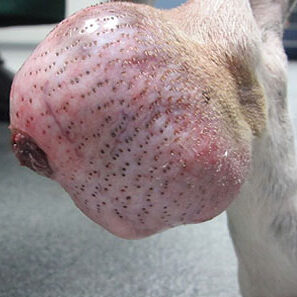Why should I bring my dog to Willows for Diagnosis and Management of Soft Tissue Sarcoma?
Willows is one the UKs only referral centres to have full-time Specialists in both the Medical and Surgical of tumour diagnosis and management. This, combined with a multi-disciplinary team approach to the management of pets with cancer, enables Willows to provide the best possible levels of care to our patients.
Our Oncology team are fully supported by Specialists in Diagnostic Imaging, Anaesthesia, Emergency and Critical Care, Clinical Nutrition and by our dedicated Interns, Nurses and Clinical support staff who provide care 24 hours a day, 365 days of the year.
What is a Soft Tissue Sarcoma?
Soft Tissue Sarcoma (STS) is an umbrella term for a group of tumours that arise from the skin and subcutaneous connective tissues such as:
- fat (liposarcoma)
- fibrous connective tissue (fibrosarcoma)
- nerves (schwannoma, malignant peripheral nerve sheath tumour, neurofibrosarcoma)
- ‘pericytes’ of small blood vessels below the skin in the subcutis (hemangiopericytoma)
These tumours are often considered collectively because of their similarity in behaviour. There are some particular subtypes of STS that are not included in this category as they are typically much more aggressive and so must be considered separately (e.g. histiocytic sarcoma, haemangiosarcoma and rhabdomyosarcoma).
Soft tissue sarcomas may arise from any anatomic site. They tend to appear as if they are discrete and well encapsulated tumours, but are actually usually very invasive into surrounding tissues. As such, local regrowth of the tumour is common after conservative/marginal surgical removal. Soft tissue sarcomas are graded as low, intermediate, or high-grade (also called 1, 2 or 3 respectively). Most soft tissue sarcomas are low to intermediate grade and have a very low chance (less than 5-10%) of spreading to other places in the body, such as lungs or other organs. High-grade sarcomas have a higher chance (25-40%) of spreading (metastasis).

How are Soft Tissue Sarcomas Diagnosed?
A fine needle aspirate is an easy, non-invasive test that can often confirm the presence of a sarcoma. During a fine needle aspirate, a small sterile needle is inserted into the tumour and material is removed which is then sent to the laboratory for testing. A biopsy may be necessary if fine needle aspirates are non-diagnostic. Biopsy or full analysis after excision is required to tell the specific type and grade of the sarcoma. Once a diagnosis is made, staging (tests to see if the cancer has spread) is recommended to rule out spread of disease and evaluate a pet’s overall health. Staging for sarcomas typically involves routine blood tests, chest X-rays, and evaluation of nearby lymph nodes (though lymph nodes are uncommonly affected by sarcoma). An abdominal ultrasound may also be recommended. CT scans are often performed as well or instead of X-rays and ultrasound.
Fig 1: Soft Tissue Sarcoma

What can I Expect if my Pet is Treated for a Soft Tissue Sarcoma?
Surgery: Surgery is the main of treatment for soft tissue sarcomas. Surgical excision must be wide and deep in order to remove all of the tumour tissue. When tumours are excised surgically with ‘clean’ surgical margins, no further treatment may be necessary. If the tumour was not removed with adequate margins as assessed by the pathologist under the microscope when they look at the excised tissue (so called ‘dirty’ margins), a second surgery may be recommended to excise more tissue and help ensure adequate removal of all tumour cells.
Radiation Therapy: Radiotherapy is the use of high dose X-rays directed at a tumour (or area where a tumour has been removed) to kill off cancer cells/cells left over after surgery. In some instances, aggressive surgery is not possible without severe disfigurement or loss of function. In cases where aggressive surgery is not possible, or despite an aggressive resection where tumour cells remain at the margins, radiation therapy can be used to prevent or delay regrowth of the tumour. Radiation therapy is well-tolerated in dogs. Side effects are brief and limited to the site where radiation therapy is performed.
Radiation therapy may also be used for large tumours that cannot be surgically removed. Radiation therapy for these tumours is not considered to be as effective as radiation therapy for microscopic disease after surgery. These tumours do not rapidly regress after radiation and ‘control’ may be defined as a slowly-regressing (six months or longer) tumour, or a tumour that stays stable in size. In some cases, the tumour may regress enough to make surgical removal possible.
Chemotherapy: Chemotherapy is sometimes recommended for high-grade sarcomas to prevent or delay the onset of distant metastases (spread to other sites). Chemotherapy is very well-tolerated in dogs on the whole, but some side effects do occur.
What can I Expect if my Pet is Treated for a Soft Tissue Sarcoma?
Soft tissue sarcomas that are low to intermediate grade and can be removed completely with surgery and have an excellent long-term prognosis.
For high-grade sarcomas, the long-term prognosis is more guarded. Chemotherapy is indicated to help delay the onset of metastasis (spread), but these dogs may unfortunately eventually succumb to spread of the tumour to other organs.
The best time to treat a soft tissue sarcoma is the very first time it occurs. Tumours that regrow after an initial surgery are often more aggressive in their behaviour. This makes the potential for metastases greater and our ability to control the tumour locally, even with additional radiation therapy, much more difficult. Early treatment is better!
To save this page as a PDF, click the button and make sure “Save as PDF” is selected.
Cancer Care
Find out more
To assist owners in understanding more about Cancer Care we have put together a range of information sheets to talk you through the some of the more common conditions seen and treated by our Specialists.

